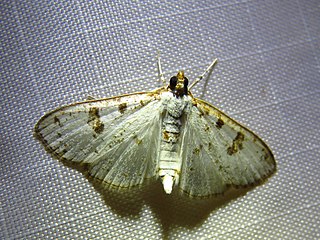
Palpita is a genus of moths of the family Crambidae. Members of the moth genus Stemorrhages may be very similar in appearance.
Palpita elealis is a moth in the family Crambidae. It was described by Francis Walker in 1859. It is found in Cameroon, the Republic of the Congo, the Democratic Republic of the Congo, Ghana, Ivory Coast, Sierra Leone, South Africa, São Tomé and Príncipe, the Gambia, Zambia and Zimbabwe.
Nausinoe capensis is a moth in the family Crambidae. It was described by Francis Walker in 1866. It is found on the Comoros and Seychelles and in Kenya and South Africa.
Palpita carbonifusalis is a moth in the family Crambidae. It was described by George Hampson in 1918. It is found in Malawi.
Palpita conistolalis is a moth in the family Crambidae. It was described by George Hampson in 1918. It is found in Nigeria.
Palpita lobisignalis is a moth in the family Crambidae. It was described by George Hampson in 1918. It is found in Malawi and South Africa.
Palpita irroratalis is a moth in the family Crambidae. It was described by George Hampson in 1912. It is found in Kenya.
Palpita ocelliferalis is a moth in the family Crambidae. It was described by George Hampson in 1912. It is found in the Democratic Republic of the Congo, Kenya, Nigeria and Uganda.
Palpita phaealis is a moth in the family Crambidae. It was described by George Hampson in 1913. It is found in Kenya.
Palpita kimballi, or Kimball's palpita moth, is a moth in the family Crambidae. It was described by Eugene G. Munroe in 1959. It is found in North America, where it has been recorded from Alabama, Florida, Georgia, Louisiana, North Carolina, Oklahoma, South Carolina, Tennessee and Virginia.

Palpita freemanalis, or Freeman's palpita moth, is a moth in the family Crambidae. It was described by Eugene G. Munroe in 1952. It is found in North America, where it has been recorded from Alabama, Illinois, Indiana, Louisiana, Maryland, Mississippi, North Carolina, Oklahoma, South Carolina, Tennessee and Texas.

Palpita illibalis, the inkblot palpita moth, is a moth in the family Crambidae. It was described by Jacob Hübner in 1818. It is found in North America, where it has been recorded from Alabama, Florida, Georgia, Maryland, Mississippi, North Carolina, Ohio, Oklahoma, Pennsylvania, South Carolina, Tennessee, Virginia and West Virginia.
Palpita jacobsalis is a moth in the family Crambidae. It was described by Hubert Marion and Pierre Viette in 1956. It is found on Madagascar.
Palpita seminigralis is a moth in the family Crambidae. It was described by George Hampson in 1899. It is found in Cameroon, the Democratic Republic of the Congo and Nigeria.

Margaroniini is a tribe of the species-rich subfamily Spilomelinae in the pyraloid moth family Crambidae. The tribe was erected by Charles Swinhoe and Everard Charles Cotes in 1889, originally as family Margaronidae.


